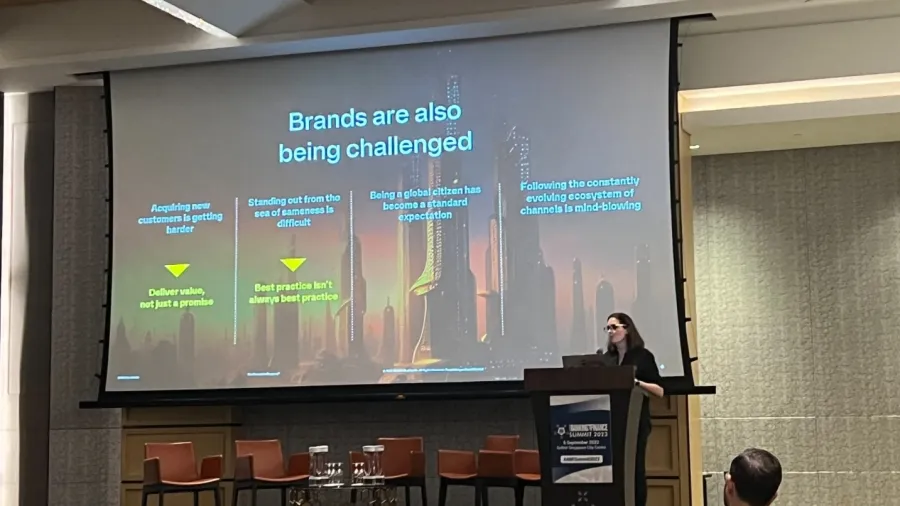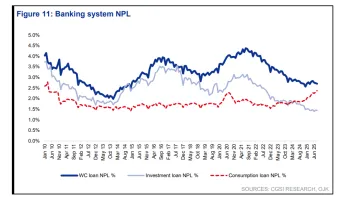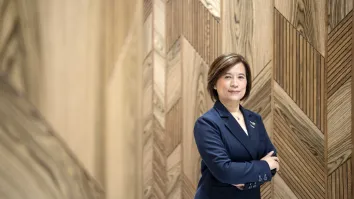
How tech disruption, branding innovation are shaping the future of finance: analysts
The afternoon sessions of ABF Summit 2023 saw analysts and bankers explore why tech and marketing are important to financial institutions.
Disruption, differentiation, and development– the three d’s that are shaping the banking and finance industry.
These are just some of the nuggets of wisdom shared by experts and analysts in the Asian Banking & Finance Summit 2023, held at Sofitel Singapore City Centre, 6 September.
The afternoon session was attended by 70 people across two tracks and eleven sessions, panel discussions, and speeches.
Simon Kucher’s Silvio Struebi kicked off the Brand and Marketing track with a discussion why dynamic pricing will allow you to capture more value.
Struebi noted the differing price thresholds of customer segments– tech savvy millennials, gig workers, urban professionals, for example.
“One of the commonalities of successful digital products that are profitable is that they focus on segments that are willing to pay for services. They offer these segments more high margin products,” Struebi noted to attendees.
Amongst benefits that banks can enjoy with dynamic pricing include increased revenue, an enhanced customer experience thanks to personalised pricing that cater to their individual needs, and improved efficiency and increased responsiveness to the market.
At the Technology track, Ravi Kanteti, associate partner, financial services, enterprise technology for Bain & Company, delved into winning business models for wealth management– and in particular, the underserved mass affluent (MA) market.
To provide better wealth services to the MA market, banks and financial institutions must first recognize one curious phenomenon about their behavior: that it is composed of paradoxes.
“MA segment is relatively risk averse, but [their] purchase behavior indicates risk appetite,” Kanteti said, noting their eagerness to invest in cryptocurrency as an example. They want exposure to higher risk investments in measured proportions but with safe guard rails, he added.
“They have limited time available to improve relatively weak financial literacy but they rely on less credible sources for financial information. They do not trust relationship managers but prefer human support at certain points in the customer journey,” Kanteki noted.
To reach them, Kanteki said that clients must feel valued with exclusive cards and privileges, but still feel like they are contributing to social change or making an impact. These include offering simpler products with digital-led journeys, and a wealth proposition that offers holistic products and perks.
Becoming the Bank of Choice
Back on the Brand and Marketing Track, UOB’s head of consumer finance and analytics, Pek Wee Leng, shared how UOB made itself the bank of choice in ASEAN.
Pek highlighted two things: partnerships and an extensive network.
“We look for like minded partners who are also invested in the same region, with the same common goals,” Pek said, when asked what UOB is looking for when embarking on partnerships. “And then we're talking about exclusivity. Ideally, we'd like to bring exclusive experience and curated value to our customers. It is also a question of whether it's the right timing and the right pace, both for the partners and for us to be able to deliver value [to our customers].”
TBWA\Singapore senior strategy director Michèle Bouquet-Kumble also graced the event, sharing her insights on how banks can build a successful brand that lasts.
Bouquet-Krumble and TBWA championed the importance of bringing disruption. Brands, in particular, must shift their view of advertising from running campaigns to building platforms, she said. Then from there, evolve the brand narrative.
To illustrate, Bouquet-Kumble shared TBWA’s work with Standard Chartered Bank and its “Here For Good” brand. First launched in 2010, TBWA and Standard Chartered worked together to relaunch the established brand in 2018, this time reintroducing the core platform idea with real stories where Standard Chartered is taking action to live up to their brand promise. Over the following years, the brand was molded to adapt to the times, with universal topics such as gender equality and protecting wildlife for example.
On the tech side, Standard Chartered’s Jim Byrden delivered a speaking session on how to prepare your bank on a rainy day– and in particular, gearing up your bank to withstand cyberattacks.
SCB’s managing director of assurance testing for group CISRO advised financial institutions to focus on the mission and business functions. “Which systems need to support critical business functions, and which may be of interest to the adversary?” Burden said, on how to identify where to begin and build up cybersecurity.
The attitude of change also plays an important role in maintaining cyber resilience. “The business, technologies, processes, and threats are ever evolving. Continue to anticipate, and adapt.”
Trend and opportunities
The different trends and opportunities currently impacting the banking industry was another key point discussed by speakers. On the Brand and Marketing Track, YCP Solidiance partner and head of M&A Advisory in Southeast Asia, Gary Murakami, spoke on the opportunities for M&A in the buy now, pay later space.
Murakami noted that alternative financing space is expected to exhibit the strongest growth of all fintech segments. BNPL occupies over 90% of all transaction values in this space. Despite this, independent BNPL face competition from banks and retailers entering the market, who look to capitalize on consumer adoption, regulatory changes, and eager sellers.
This presents an attractive opportunity for banks to acquire a BNPL service provider instead of building one from scratch, if they are interested.
“M&A activity is poised to further accentuate prevailing industry dynamics, driven by major retailers seeking the strategic advantages it offers over organic growth,” Murakami noted.
Aurexia Singapore director Sebastian L. Sohn graced the event to talk about the 2023 bank failures in the West, and how it will affect the banking industry in Asia.
Earlier this year, America saw three banks collapse: Signature Bank, Silicon Valley Bank, and First Republic Bank. Europe, meanwhile, was rocked with the shotgun acquisition of Credit Suisse by its Swiss rival UBS, arguably making it the biggest bank “failure” of the year.
In his speaking session, Sohn outlined regulators’ response to the crisis, and how this may lead to more regulation to tighten banks’ balance sheets, such as imposing higher minimum assets and a greater emphasis on modernising banks’ systems.
In an event that authorities decide to introduce new common-equity based capital composition, they may even opt to remove AT1 products. The latter had led to much controversy in the first half of the year after bondholders found their Credit Suisse AT1 bonds basically useless– a total of $17b of investors’ money, all rendered moot in a blink of an eye.
Banks are called to take note of lessons learned during these events, for future strategy and business model decisions. The failures also highlighted the need for lenders to reduce concentrations, review their liquidity and interest rate risk management, and adopt better stress testing and recovery planning, according to Sohn.
Mazars’ Athreya HD, partner for financial services advisory, led a panel session on how fintechs are accelerating financial inclusion and access to banking services. Funding Societies CEO Kelvin Teo; Finaxar group CEO Sian W. Tan; and Validus co-founder and executive chairman Vikas Nahata joined Athreya on stage to discuss the role of fintechs in disrupting the traditional banking pathways and opening up new ones, breaking down the barriers to entry for the underbanked and underserved.
Back at the tech track, David Fergusson, CEO of Atlas Consolidated Pte Ltd., delivered a panel on how open banking will impact the financial players.
Fergusson highlighted the billion-dollar opportunity present in open banking and embedded finance, calling it “one of the biggest economic opportunities in finance in decades.”
In particular, Fergusson shared the success of Atlas Consolidated’s HugoHub.The “hub” is mainly used by two of its pioneer services– HugoSave and HugoBank– and offers a “modular” wholesale business experience to clients.
Closing the brand and marketing track, EY partner and ASEAN sustainable finance lead Aloysius Fua led a panel discussion on how companies and investors can better connect their sustainability-related expectations and goals.
Fua was joined by Citibank’s Rapheal Erasmus, MD & Asia-Pacific Head of Sustainability and Corporate Transitions; Standard Chartered’s Eugenia Koh, Global Head, Sustainable Finance Consumer, Private and Business Banking; and Melissa Moi, Head of Sustainable Business, Corporate Sustainability Office, UOB.
An old solution given new life
Beyond generative AI use cases, artificial intelligence in itself is of much interest to banks– both as a means to drive customer innovation in the form of products offered, and experiences served.
In the event’s AI panel, moderator Fridolin Blumer, CEO & founder of XiXun Asia, asked tech leaders from Security Bank, Standard Chartered Bank, Citibank Singapore, and ANEXT Bank about how they are using AI in their operations to enhance offerings: from regulation, to exploring faster settlements, and offering more personalized services.
When asked about the negative reputation that AI has amassed in the general public due to the rise of ChatGPT and AI-generated content– with social media decrying the unauthorized use of individuals’ works to train the AI in generating a specific content– ANEXT Bank’s chief technology officer Kai Qiu noted that it’s neither here nor there for the banking industry.
“From our perspective, and especially as a tech guy, I feel that it’s just still technology that a human created. It’s the manner of how you use it,” said Qiu, who was one of the four panelists alongside Lucose Eralil, EVP and head of enterprise technology and operations, Security Bank; Jim Byrden, managing director of assurance and testing for group CISRO, Standard Chartered Bank; and Nilesh Kumar, digital channels and experience head, Citibank Singapore
AI as a technology is nothing new, according to Qiu, and most financial institutions have used AI in different business lines for a long time.
“AI is a big word. It offers a lot of different capabilities. For us, as a bank, we look at use cases, we look at business objectives, we look at pain points, and we use that to resolve it. So if AI technology can resolve your business pain point, and the objective can be achieved [using AI]. It’s the result of it [that matters],” Qiu further noted, adding that AI as a technology is nothing new, and there should be no cause to fear.



















 Advertise
Advertise






